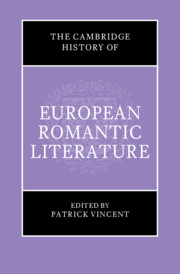Book contents
- The Cambridge History of European Romantic Literature
- The Cambridge History of European Romantic Literature
- Copyright page
- Contents
- Contributors
- Acknowledgements
- Note on the Text
- Chronology
- Introduction
- Part I Romantic Genealogies (1750–1790)
- Part II Revolution to Restoration (1790–1815)
- 7 Transcendental Revolutions
- 8 Citizens of the World
- 9 Romantic Loss, Emigration, and Exile
- 10 Women Writers’ Networks
- 11 Romantic Nationalisms
- 12 Shakespeare and Romantic Drama
- 13 Classics and Romantics
- Part III Restoration to Revolution (1815–1850)
- Further Reading
- Index
11 - Romantic Nationalisms
from Part II - Revolution to Restoration (1790–1815)
Published online by Cambridge University Press: 10 January 2024
- The Cambridge History of European Romantic Literature
- The Cambridge History of European Romantic Literature
- Copyright page
- Contents
- Contributors
- Acknowledgements
- Note on the Text
- Chronology
- Introduction
- Part I Romantic Genealogies (1750–1790)
- Part II Revolution to Restoration (1790–1815)
- 7 Transcendental Revolutions
- 8 Citizens of the World
- 9 Romantic Loss, Emigration, and Exile
- 10 Women Writers’ Networks
- 11 Romantic Nationalisms
- 12 Shakespeare and Romantic Drama
- 13 Classics and Romantics
- Part III Restoration to Revolution (1815–1850)
- Further Reading
- Index
Summary
Chapter Eleven presents Romanticism as a nationalist phenomenon. After defining Romantic nationalism, it reviews three intersecting phenomena central not only to European Romanticism but also to nationalism: the linguistic revolution, the spread of idealism, and the rise of historicist dialectics. In each case, the author shows how these Romantic principles spread transnationally across various media, influencing political thought and emerging nationalisms. The wide-ranging chapter addresses France’s revolutionary nationalism, recuperated under the Restoration, and even more importantly the German nationalism that arose in reaction to French hegemony, but also touches on other Northern, Central and Eastern-European nations that have so far received little coverage in the volume, including, among others, Finland, Latvia, Estonia, Ireland, the Netherlands, Hungary, Slovakia, Slovenia, Croatia, and Albania. Its looks at the influence of philology on folklore, and on other literary genres such as the national epic, the patriotic hymn, and the historical novel, as well as the other arts, including music, architecture, and painting. Leerssen argues that Jacob Grimm and his teacher, the legal scholar Carl von Savigny, played central roles in the development of Romantic nationalism and of the notion of Volksgeist.
- Type
- Chapter
- Information
- The Cambridge History of European Romantic Literature , pp. 352 - 374Publisher: Cambridge University PressPrint publication year: 2023

